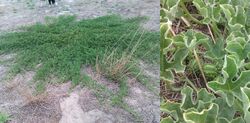Biology:Cucumis myriocarpus
| Paddy melon | |
|---|---|

| |
| Scientific classification | |
| Kingdom: | Plantae |
| Clade: | Tracheophytes |
| Clade: | Angiosperms |
| Clade: | Eudicots |
| Clade: | Rosids |
| Order: | Cucurbitales |
| Family: | Cucurbitaceae |
| Genus: | Cucumis |
| Species: | C. myriocarpus
|
| Binomial name | |
| Cucumis myriocarpus E. Mey. ex Naud.
| |
Cucumis myriocarpus, the gooseberry cucumber,[1] gooseberry gourd,[2] paddy melon, Mallee Pear or prickly paddy melon is a prostrate or climbing annual herb native to tropical and southern Africa.[3] It has small, round, yellow-green or green-striped fruit with soft spines, small yellow flowers and deeply lobed, light green leaves. The melon occurs in disturbed soil and cleared or bare areas, and thrives on summer moisture.[3]
The fruit and foliage are toxic due to the presence of cucurbitacin. The plant is toxic to humans as well as to horses, sheep, cattle and pigs and it has been associated with stock deaths.[4] It has been used by humans as an emetic.[5] There are records of poisoning occurring in humans.[6]
The melon is a noxious weed in Australia and in California , where it may also be known as prickly paddy melon, bitter apple, gooseberry gourd and gooseberry cucumber.[4][5][7][8] One of many invasive species in Australia, it is highly damaging to the economy, with the farmers bearing most of the cost.[9][10]
Cucumis myriocarpus (paddy melon) is often confused with Citrullus lanatus (the Afghan melon, camel melon or bitter wooly melon) in Australia, where both species are introduced. Cucumis myriocarpus has many small fruit, hidden under the leaves. The fruit are smaller than a golf ball and green in colour, developing to yellow on maturity. The larger melons commonly seen on roadsides in rural Australia are in fact Citrullus lanatus, a wild relative of the watermelon.[3][11][12] The confusion is widespread in Australia, such that in common parlance, the term "paddy melon" is understood to mean the larger green/yellow fruit of the Citrullus lanatus. Children in rural Australia often use the fruit of this plant as an opportunistic source of entertainment, for example by throwing it at each other's feet, or squeezing the fruit to shoot the seeds at each other[citation needed].
Paddy and Afghan melons (collectively referred to as wild melons) sometimes occur in mixed infestations in Australia.[3] They vary only slightly in colour and appearance, with Citrullus lanatus leaves being a little more variegated than those of Cucumis myriocarpus.[13] Fruit size is the clearest identifying factor. However, management of all wild melons is similar, apart from some variation in sensitivity to the herbicide glyphosate.[4][13] Mechanical removal of small infestations is the simplest control method, and cultivation at early stages of growth can be effective. Large infestations are sometimes controlled by the spray-graze method, in which plants are sprayed with a sublethal dose of hormone herbicide to make them more palatable to stock, and the area is heavily grazed three days later. Toxicity is managed by making other feed available.[3][6]
Both wild melon species have a similar unpleasant odor when broken or disturbed. That makes them less palatable to stock, so poisoning tends to occur only when little other feed is available.[6]
The plant occurs in Spain, where it is naturalized and known by the common names of habanera or sandía habanera.[5]
References
- ↑ (xls) BSBI List 2007, Botanical Society of Britain and Ireland, https://bsbi.org/download/3542/, retrieved 2014-10-17
- ↑ "Cucumis myriocarpus". Natural Resources Conservation Service PLANTS Database. USDA. https://plants.usda.gov/core/profile?symbol=CUMY. Retrieved 17 January 2016.
- ↑ 3.0 3.1 3.2 3.3 3.4 Borger, John, "Paddy and Afghan Melons", [1] , July 2005, retrieved on 3 March 2012
- ↑ 4.0 4.1 4.2 Pakskowska, Grazyna, "Cucumis Myriocarpus Naudin/Prickly Paddy Melon", description on Florabase [2] retrieved on 3 March 2012
- ↑ 5.0 5.1 5.2 McKenzie R.A. et al. (1988). Prickly paddy melon (Cucumis myriocarpus) poisoning of cattle. Australian Veterinary Journal 65(6):167-70.
- ↑ 6.0 6.1 6.2 Herbiguide: Prickly Paddymelon [3] retrieved on 3 March 2012
- ↑ McLellan, Richard (30 November 2020). "Paddy Melon picking at Hamelin". https://www.bushheritage.org.au/blog/learning-more-about-camel-melons.
- ↑ "Summer weeds". Western Australia. Department of Primary Industries and Regional Development. 24 August 2020. https://www.agric.wa.gov.au/postharvest/summer-weeds?page=0%2C2.
- ↑ Khan, Jo (29 July 2021). "Invasive species have cost Australia $390 billion in the past 60 years, study shows". Australian Broadcasting Corporation. https://www.abc.net.au/news/science/2021-07-30/invasive-species-cost-billions-australia/100333710.
- ↑ Shaik, Razia S.; Burrows, Geoffrey E.; Urwin, Nigel A. R.; Gopurenko, David; Lepschi, Brendan J.; Weston, Leslie A. (2017-02-01). "The biology and management of prickly paddy melon (Cucumis myriocarpus L.), an important summer annual weed in Australia". Crop Protection 92: 29–40. doi:10.1016/j.cropro.2016.10.005. ISSN 0261-2194. https://www.sciencedirect.com/science/article/pii/S0261219416302824.
- ↑ Cotton Catchment Communities (CRC) Weed Identification Tools [4] retrieved on 3 March 2012
- ↑ Randall, Rod, Plant Protection Society of WA [5] retrieved on 4 March 2012
- ↑ 13.0 13.1 Pursehouse Rural Newsletter, January 2006 Issue, Weed Identification: Melons [6] retrieved on 3 March 2012
External links
Wikidata ☰ Q5192439 entry
 |

